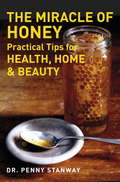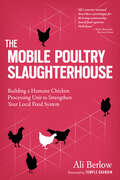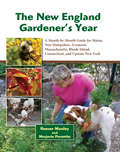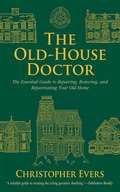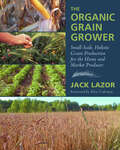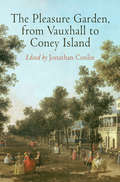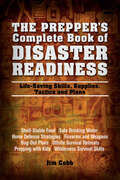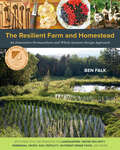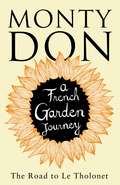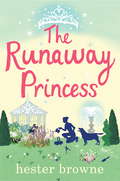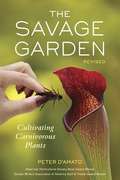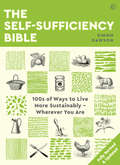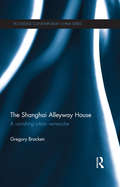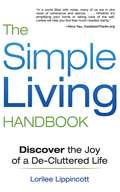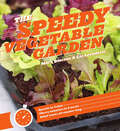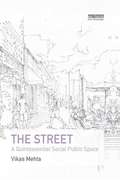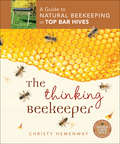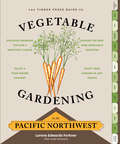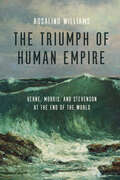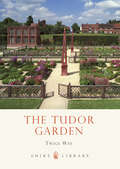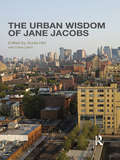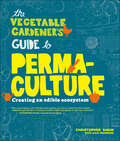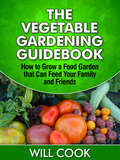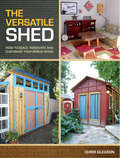- Table View
- List View
The Miracle of Honey
by Dr Penny StanwayThe Miracle of Honey is a compact yet comprehensive and authoritative guide to honey, with helpful information on every possible way to use this wonderful product of nature - not only in cooking but also for health and well-being. The book opens with the history of honey and its popularity around the world over the millennia. The author discusses whether honey is a miracle medicine, a valuable natural remedy or just a useful part of a healthy diet. The first part of the book outlines the varieties of honey and how they differ. A digest of the contents of honey and how they affect health is followed by guidance on how to choose, use and store honey. The second part offers guidance on making honey-containing beauty products. There is also a comprehensive A-Z of ailments that may benefit from honey, practical instructions on how to use honey or honey-associated products such as beeswax to keep your home sparkling and sweet-smelling, and a variety of recipes for honey-containing dishes. The final section looks at bee-keeping and the vital subject of bee health and survival.
The Mobile Poultry Slaughterhouse: Building a Humane Chicken-Processing Unit to Strengthen Your Local Food System
by Temple Grandin Ali BerlowIf you’re raising poultry for meat and lack easy access to a humane slaughterhouse, a mobile slaughter and processing unit may be the solution. <P><P>Ali Berlow shows you how to build a unit that accommodates all types of poultry and can easily be moved to any location, making it a great cooperative investment for a community of small-scale farmers. <P><P>Covering the mechanics of construction, sanitation, safety, and permitting processes, this guide shows you how a mobile slaughterhouse can make your poultry operation more self-sufficient.
The Mosaics of Roman Crete
by Rebecca J. SweetmanThis book examines the rich corpus of mosaics created in Crete during the Roman and Late Antique eras. It provides essential information on the style, iconography, and chronology of the material, as well as discussion of the craftspeople who created them and the technologies they used. The contextualized mosaic evidence also reveals a new understanding of Roman and Late Antique Crete. It helps shed light on the processes by which Crete became part of the Roman Empire, its subsequent Christianization, and the pivotal role the island played in the Mediterranean network of societies during these periods. This book provides an original approach to the study of mosaics and an innovative method of presenting a diachronic view of provincial Cretan society.
The New England Gardener's Year: A Month-by-Month Guide for Maine, New Hampshire, Vermont. Massachusetts, Rhode Island, Connecticut, and Upstate New York
by Reeser Manley Marjorie PerontoThis comprehensive full-color what-to/when-to/how-to reference manual covers every garden and landscape planting including the most proven and popular as well as many native New England plants that deserve to be better known. Month-by-month guidance from March through October—with suggested dates for planting and tending adjusted for each zone—is augmented by advice on such topics as soil testing, composting, pruning, landscape design, and how to provide a season-long source of pollen and nectar for beneficial insects. Gardeners will find advice and photos for adapting to any microclimate or situation including shade; wet soil; coastal landscapes; container, raised-bed, and extended-season gardening; and much more. Gardeners and landscapers will treasure this book for its elegant writing and full-color photography, its photo-essay tours of outstanding owner-maintained gardens throughout New England, its focus on organic methods and native plants, and its guidance on integrating gardens of every variety into their surrounding landscapes. Photo sequences of key techniques enhance the book, which is designed and indexed to provide instant access to the information a gardener needs at hand. In Reeser Manley and Marjorie Peronto’s view, the plots of land on which we live are not our “yards” but our gardens—extensions of the surrounding natural world—and we, as gardeners, are caretakers of that world. They advocate gardening in tune with nature— avoiding pesticides, chemical fertilizers, and invasive plants, while creating a garden that enhances local biodiversity. The New England Gardener’s Year will guide you to a garden of great beauty and bountiful harvests.
The Old-House Doctor: The Essential Guide to Repairing, Restoring, and Rejuvenating Your Old Home
by Christopher EversOld houses are charming, but owning one can be a labor of love. Expert carpenter and house "doctor" Christopher Evers equates old homes with ailing patients, describing how you can successfully "treat" your old house and make it good as new. With over 300 clear, line illustrations, Evers provides a practical guide to repairing, renovating, and preserving your old house--basement to attic--so you can enjoy it for years to come. Evers gives detailed instructions on the "anatomy" of old homes as well as how to fix a variety of problems, including:Repairing old plumbing fixturesReplacing shingles on the roofStraightening the house’s frameRewiring old electrical systemsRemoving old wallpaperProtecting against termites and other harmful pestsAdding insulation for better energy efficiencyFixing old eavesReinstalling windows and doorsAnd more!A classic in old-home repair, The Old-House Doctor is an invaluable, and timeless, guide for keeping your old home in tip-top shape, while meeting your modern needs.
The Organic Grain Grower: Small-Scale, Holistic Grain Production for the Home and Market Producer
by Jack Lazor&“The Organic Grain Grower is the best resource we&’ve seen for small-scale grain growers everywhere. . . . [Lazor&’s] passion comes alive in this fine guidebook&’s depth of detail.&”—Mother Earth NewsThe ultimate guide to growing organic grains on a small and ecological scale The Organic Grain Grower is invaluable for both home-scale and commercial producers interested in expanding their resiliency and crop diversity through growing their own grains. Longtime farmer and organic pioneer Jack Lazor covers how to grow and store wheat, barley, oats, corn, dry beans, soybeans, pulse crops, oilseeds, grasses, nutrient-dense forages, and lesser-known cereals. In addition to detailed cultivation and processing information, Lazor argues the importance of integrating grains on the organic farm (not to mention for the local-food system) for reasons of biodiversity and whole farm management. Including extensive information on:The history of grain growing and consumption in North AmericaThe twenty-first century and the birth of the local-food movementConsidering your farm&’s scale and climateUnderstanding soil fertility and structurePlanting your crop (including spring vs. fall cereals and preparing your soil)The growing and ripening process (reproductive, milk, hard-and-soft dough stages)The grain harvestPreparing grain for sale, storage, or end use (drying, cleaning seed, grain handling)Seed breeding and savingMachinery, infrastructure, and processing (both home-scale tools and larger farm equipment)Grinding grains for livestock rations (including how to put together a ration based on protein content) and sample rations for dairy cows, pigs, and chickensProcessing grains for human consumptionAdditional resources and information for new grain farmers, and more…Beginners will learn how to grow enough wheat for a year&’s supply of bread flour for their homestead, and farmers will learn how to become part of a grain co-op, working alongside artisan bakers and mills. Never before has there been a guide to growing organic grains applicable both for the home-scale and professional farming scale.This will be a classic for decades to come and a crucial addition to any farmer&’s, homesteader&’s, gardener&’s, agronomist&’s, or seed-saver&’s library.
The Pleasure Garden, from Vauxhall to Coney Island
by Jonathan ConlinSummers at the Vauxhall pleasure garden in London brought diverse entertainments to a diverse public. Picturesque walks and arbors offered a pastoral retreat from the city, while at the same time the garden's attractions indulged distinctly urban tastes for fashion, novelty, and sociability. High- and low-born alike were free to walk the paths; the proximity to strangers and the danger of dark walks were as thrilling to visitors as the fountains and fireworks. Vauxhall was the venue that made the careers of composers, inspired novelists, and showcased the work of artists. Scoundrels, sudden downpours, and extortionate ham prices notwithstanding, Vauxhall became a must-see destination for both Londoners and tourists. Before long, there were Vauxhalls across Britain and America, from York to New York, Norwich to New Orleans.This edited volume provides the first book-length study of the attractions and interactions of the pleasure garden, from the opening of Vauxhall in the seventeenth century to the amusement parks of the early twentieth. Nine essays explore the mutual influences of human behavior and design: landscape, painting, sculpture, and even transient elements such as lighting and music tacitly informed visitors how to move within the space, what to wear, how to behave, and where they might transgress. The Pleasure Garden, from Vauxhall to Coney Island draws together the work of musicologists, art historians, and scholars of urban studies and landscape design to unfold a cultural history of pleasure gardens, from the entertainments they offered to the anxieties of social difference they provoked.
The Prepper's Complete Book of Disaster Readiness: Life-Saving Skills, Supplies, Tactics and Plans (Preppers)
by Jim CobbMake sure your survival plan is complete from A to Z with this comprehensive disaster prep guide. When preparing to face a disaster scenario, details can mean the difference between life and death. If you overlook one vital area, fail to stock one supply or underestimate one potential danger, your whole plan could come crashing down. The Prepper&’s Complete Book of Disaster Readiness guarantees you won&’t miss a thing as you prepare to face the most critical challenges. This bible of prepping shows each and every life-saving step necessary to keep your family alive and well when the world around you is in chaos, including how to: • Efficiently store water and acquire additional fresh water after a collapse • Build a shelf-stable food stock and supplement it by harvesting edible wild plants • Strengthen the security of your home as well as have a back-up bug-out plan • Treat illness and stay healthy when there are no doctors or hospitals • Build a safe and secure survival retreat that allows for long-term off-the-grid living
The Resilient Farm and Homestead: An Innovative Permaculture and Whole Systems Design Approach
by Ben FalkA practical, comprehensive, and essential how-to manual with information on growing perennial crops, soil fertility, water security, nutrient dense food, and more! "Essential reading for the serious prepper as well as for everyone interested in creating a more resilient lifestyle."—Carol Deppe, author of The Resilient GardenerThe Resilient Farm and Homestead is for readers ready to not just survive, but thrive in changing, unpredictable times. It offers the tools to develop durable, beautiful, and highly functional human habitat systems anchored by preparation, regeneration, and resiliency. Ben Falk is a land designer and site developer whose research farm has drawn national attention. The site is a terraced paradise on a hillside in Vermont that would otherwise be overlooked by conventional farmers as unworkable. Falk’s wide array of fruit trees, rice paddies (relatively unheard of in the Northeast), ducks, nuts, and earth-inspired buildings is a hopeful image for the future of regenerative agriculture and modern homesteading.The book covers nearly every strategy Falk and his team have been testing at the Whole Systems Research Farm over the past decade, as well as experiments from other sites Falk has designed through his off-farm consulting business.The book includes detailed information on:Gravity-fed water systemsFuelwood hedge production and processingHuman health through nutrient-dense production strategiesRapid topsoil formation and remineralizationAgroforestry, silvopasture & grazingEarthworksSpecies compositionThe site-design process and site managementEcosystem services, especially regarding flood mitigationTools, equipment, and appropriate technology guidesA "Homestead Vulnerability" checklistResiliency Aptitude quiz and skills list for emergencies And much more!Complete with gorgeous photography and detailed design drawings throughout!The Resilient Farm and Homestead is more than just a book of tricks and theories for regenerative site development. It offers actual working results from a complex farm-ecosystems based on research from the “great thinkers” in permaculture, and presents a viable home-scale model for an intentional food-producing ecosystem in cold climates, and beyond. Inspiring to would-be homesteaders everywhere, but especially for those who find themselves with “unlikely” farming land, Falk is an inspiration in what can be done by imitating natural systems, and making the most of what we have by re-imagining what’s possible. A gorgeous case study for the homestead of the future.
The Road to Le Tholonet: A French Garden Journey
by Monty DonThis is not a book about French Gardens. It is the story of a man travelling round France visiting a few selected French gardens on the way.Owners, intrigues, affairs, marriages, feuds, thwarted ambitions and desires, the largely unnamed ordinary gardeners, wars, plots and natural disasters run through every garden older than a generation or two and fill every corner of the grander historical ones. Families marry. Gardeners are poached. Political allegiances forged and shattered. The human trail crosses from garden to garden. They sit in their surrounding landscape, not as isolated islands but attached umbilically to it, sharing the geology, the weather, food, climate, local folklore, accent and cultural identity. Wines must be drunk and food tasted. Recipes found and compared. The perfect tarte-tartin pursued. None of these things can be ignored or separated from the shape and size of parterre, fountain, herbaceous border or pottager. So this is a book filled with stories and information, some of it about French gardens and gardening, but most of it about what makes France unlike anywhere else.From historical gardens like Versailles,Vaux le Vicomte and Courances to the kitchen gardens of the Michelin chef Alain Passard. There will be grand potagers like Villandry and La Prieure D'Orsan and allotments and back gardens spotted on the way. Monty also celebrates the obvious French associations of food and wine and finds gardens dedicated to vegetables, herbs and fruit.It is a book that any visitor to France, whether gardeners or not, will want to read both as a guide and an inspiration. It is a portal to get under the French cultural skin and to understand the country, in all its huge variety and disparity, a little better.
The Runaway Princess: a feel-good and heart-warming comedy for all true romantics
by Hester BrowneLove is hard enough without worrying if your tiara's straight . . .Amy Wilde is tired of the idiots her glamorous flatmate Jo tries to set her up with - she'd much rather be landscaping a garden with her dog Badger at her side than trying to find the man of her dreams. That is, until she meets Leo Wolfsburg. Handsome, polite, funny, intriguing - Leo is everything Amy could want in a man. Best of all, the attraction seems mutual.But Leo's lifestyle is a world away from her own. Private planes, charity balls, exclusive members' clubs . . . They're from two different worlds, but is that enough to keep them apart?'An adorable heroine, divine hero and gorgeous writing - basically, it's just perfect' JILL MANSELL'Clear your diary and turn off your phone. Prince Harry can call you back later . This is a book you won't want to put down' CHRISSIE MANBYREADERS LOVE THE RUNAWAY PRINCESS'This has everything: emotion, wit, real life and true romance' *****'Ended up staying all night reading it' *****'Fantastic from start to finish' *****'Perfect escapism' *****'Good old-fashioned romance complete with a Prince Charming' *****
The Savage Garden, Revised: Cultivating Carnivorous Plants
by Peter D'AmatoFor fifteen years, The Savage Garden has been the number one bestselling bible for those interested in growing carnivorous plants. This new edition is fully revised to include the latest developments and discoveries in the carnivorous plant world, making it the most accurate and up to date book of its kind. You may be familiar with the Venus flytrap, but did you know that some pitcher plants can--and do--digest an entire rat? Or that there are several hundred species of carnivorous plants on our planet? Beautiful, unusual, and surprisingly easy to grow, flesh-eating plants thrive everywhere from windowsills to outdoor container gardens, in a wide variety of climates. The Savage Garden is the most comprehensive guide to these fascinating oddities, gloriously illustrated with more than 200 color photos. Fully revised with the latest developments in the carnivorous plant world, this new edition includes: * All the basics--from watering and feeding to modern advances in artificial lighting, soil, and fertilizers. * Detailed descriptions of hundreds of plants, including many of the incredible new species that have been recently discovered and hybridized. * Cultivation and propagation information for all the plant families: pitcher plants, Venus flytraps, sundews, rainbow plants, bladderworts, and many other peculiar plants from the demented mind of Mother Nature. Whether you're a beginner with your first flytrap or an expert looking for the latest exotic specimen, this classic book has everything you need to grow your very own little garden of horrors.
The Self-sufficiency Bible: 100s of Ways to Live More Sustainably Wherever You Are
by Simon DawsonA fully revised and updated edition of the self-sufficiency classic. Packed with practical information and expert advice on everything from gardening to cooking, and from health and beauty to raising livestock, this is the indispensable guide to living more sustainably, whether you live in a city apartment block or on a rural smallholding."A treasure-trove of brilliant ideas and easy-to-follow step-by-step instructions" - Adam Henson, BBC One's CountryfileIn our current era of pandemic and environmental crisis, self-sufficiency is a means of taking control of our lives and safeguarding for the future - and this new, fully updated edition of the sustainability classic will help every householder do just that. You'll find all the practical information and expert guidance you need on every aspect of self-sufficiency, from gardening and baking through health, beauty and cleaning to foraging and livestock, whatever your needs, circumstances and resources. This means that the gardening chapter, for example, is appropriate both for people with an urban back yard or a more substantial plot of land. Written in a down-to-earth, engaging and often amusing style, and charmingly illustrated with line drawings, the book will appeal to anyone who wants to be more creative, resourceful and independent, who wants to rediscover their inner hunter-gatherer, to single people as much as to large families, and to parents looking to equip their children with basic life skills.
The Shanghai Alleyway House: A Vanishing Urban Vernacular (Routledge Contemporary China Series)
by Gregory BrackenAs a nineteenth-century commercial development, the alleyway house was a hybrid of the traditional Chinese courtyard house and the Western terraced one. Unique to Shanghai, the alleyway house was a space where the blurring of the boundaries of public and private life created a vibrant social community. In recent years however, the city’s rapid redevelopment has meant that the alleyway house is being destroyed, and this book seeks to understand it in terms of the lifestyle it engendered for those who called it home, whilst also looking to the future of the alleyway house. Based on groundwork research, this book examines the Shanghai alleyway house in light of the complex history of the city, especially during the colonial era. It also explores the history of urban form (and governance) in China in order to question how the Eastern and Western traditions combined in Shanghai to produce a unique and dynamic housing typology. Construction techniques and different alleyway house sub-genres are also examined, as is the way of life they engendered, including some of the side-effects of alleyway house life, such as the literature it inspired, both foreign and local, as well as the portrayal of life in the laneways as seen in films set in the city. The book ends by posing the question: what next for the alleyway house? Does it even have a future, and if so, what lies ahead for this rapidly vanishing typology? This interdisciplinary book will be welcomed by students and scholars of Chinese studies, architecture and urban development, as well as history and literature.
The Simple Living Handbook: Discover the Joy of a De-Cluttered Life
by Lorilee LippincottWhere did all this stuff come from? I don't have time for a life. I need to get away! Ever feel this way? Society is quick to fill our minds and homes with all the latest gadgets, tools, obligations, and entertainment, but what happens when it all doesn't fit? The Simple Living Handbook is a how-to memoir about creating a life that has space for what really matters to you.Lippincott's road to simplicity started in the fall of 2010 when she was on the verge of a breakdown. Her life was basically "normal"--husband, two kids, comfortable home, three home businesses--but she felt like she was running a rat race. She was desperate for more time and space to focus on family, health, and her own interests. So she and her husband decided to cut back on clutter--drastically. Now the family of four lives in a one-bedroom apartment with only the possessions they actually need and use; they stick to a simple diet of only whole foods "that God would recognize"; and they have managed to become productive without feeling busy. They've never been happier or healthier.Through personal stories, advice, and tips, Lippincott teaches how to make the hard decisions necessary to simplify your home and your schedule. Beyond that, she addresses the hidden emotional hoarding that threatens to keep our souls running in circles. Through her inspiring story, readers will learn to take a step back, reassess priorities, and commit to making space for those people and things that really matter.
The Speedy Vegetable Garden
by Mark Diacono Lia LeendertzTypically, vegetable gardening is about the long view: peas sown in spring aren't harvested until summer, and tomatoes started indoors in February can't be eaten until July. But it's not true for all plants. Some things can be planted and eaten in weeks, days, even hours.The Speedy Vegetable Garden highlights more than 50 quick crops, with complete information on how to sow, grow, and harvest each plant, and sumptuous photography that provides inspiration and a visual guide for when to harvest. In addition to instructions for growing, it also provides recipes that highlight each crop’s unique flavor, like Chickpea sprout hummus, stuffed tempura zucchini flowers, and a paella featuring calendula. Sprouted seeds are the fastest. Microgreens can be harvested in weeks: cilantro, 14 days after planting; arugula and fennel in 10 days. And a handful of vegetable varieties grow more quickly than their slower relatives, like dwarf French beans (60 days), cherry tomatoes (65 days), and early potatoes (75 days).The Speedy Vegetable Garden puts fresh, seed-to-table food at your fingertips, fast!
The Street: A Quintessential Social Public Space
by Vikas MehtaReceived the Environmental Design Research Association's 2014 Place Book Award Shortlisted for the UDG Francis Tibbalds Book Award 2014 Good cities are places of social encounter. Creating public spaces that encourage social behavior in our cities and neighborhoods is an important goal of city design. One of the cardinal roles of the street, as public space, is to provide a setting for sociability. How do we make sociable streets? This book shows us how these ordinary public spaces can be planned and designed to become settings that support an array of social behaviors. Through carefully crafted research, The Street systematically examines people's actions and perceptions, develops a comprehensive typology of social behaviors on the neighborhood commercial street and provides a thorough inquiry into the social dimensions of streets. Vikas Mehta shows that sociability is not a result of the physical environment alone, but is achieved by the relationships between the physical environment, the land uses, their management, and the places to which people assign special meanings. Scholars and students of urban design, planning, architecture, geography and sociology will find the book a stimulating resource. The material is also directly applicable to practice and should be widely read by professional urban designers, planners, architects, and others involved in the design, planning, and implementation of commercial streets.
The Thinking Beekeeper: A Guide to Natural Beekeeping in Top Bar Hives (Mother Earth News Books for Wiser Living)
by Christy HemenwayA beginner&’s complete guide to keeping bees in top bar hives, and why. What&’s the buzz about the growing popularity of backyard beekeeping? Providing habitat for bees, pollinating your garden, and producing honey for your family are some of the compelling reasons for taking up this exciting hobby. But conventional beekeeping requires a significant investment and has a steep learning curve. The alternative? Consider beekeeping outside the box.The Thinking Beekeeper is the definitive do-it-yourself guide to natural beekeeping in top bar hives. Based on the concept of understanding and working with bees&’ natural systems as opposed to trying to subvert them, the advantages of this approach include:· Simplicity, sustainability, and cost-effectiveness · Increased safety due to less heavy lifting and hive manipulation · Chemical-free colonies and healthy hives Top bar hives can be located anywhere bees have access to forage, and they make ideal urban hives. Emphasizing the intimate connection between our food systems, bees, and the well-being of the planet, The Thinking Beekeeper will appeal to the new breed of beekeeper who is less focused on maximizing honey yield, and more on ensuring the viability of the bee population now and in the coming years.Mother Earth News Books for Wiser Living Recommendation&“You&’ll find information you need here that&’s not available anywhere else. Both you and your bees will benefit from Christy&’s approach, advice, and philosophy.&” —Kim Flottum, editor, Bee Culture Magazine&“A unique and exceptional resource for the beginning beekeeper.&” —Marty Hardison, top bar beekeeper, educator and international developmental beekeeping consultant
The Timber Press Guide to Vegetable Gardening in the Pacific Northwest: A Timber Press Guide (Regional Vegetable Gardening Series)
by Lorene Edwards ForknerThere is nothing more regionally specific than vegetable gardening. What to plant, when to plant it, and when to harvest are unique decisions based on climate, weather, and first and last frost.The Timber Press Guide to Vegetable Gardening: Pacific Northwest is a growing guide that truly understands the unique eccentricities of the Northwest growing calendar, covering Oregon, Washington, southeastern Alaska, and British Columbia. The month-by-month format makes it perfect for beginners and accessible to everyone—you can start gardening the month you pick it up. Starting in January? The guide will show you how to make a seed order, plan crop rotations and succession plantings, and plant a crop of microgreens. No time to start until July? You can start planting beets, carrots, chard, kale, parsnips, and spinach for an early fall harvest.
The Triumph of Human Empire: Verne, Morris, and Stevenson at the End of the World
by Rosalind WilliamsIn the early 1600s, in a haunting tale titled New Atlantis, Sir Francis Bacon imagined the discovery of an uncharted island. This island was home to the descendants of the lost realm of Atlantis, who had organized themselves to seek "the knowledge of Causes, and secret motions of things; and the enlarging of the bounds of Human Empire, to the effecting of all things possible. " Bacon's make-believe island was not an empire in the usual sense, marked by territorial control; instead, it was the center of a vast general expansion of human knowledge and power. Rosalind Williams uses Bacon's island as a jumping-off point to explore the overarching historical event of our time: the rise and triumph of human empire, the apotheosis of the modern ambition to increase knowledge and power in order to achieve world domination. Confronting an intensely humanized world was a singular event of consciousness, which Williams explores through the lives and works of three writers of the late nineteenth century: Jules Verne, William Morris, and Robert Louis Stevenson. As the century drew to a close, these writers were unhappy with the direction in which their world seemed to be headed and worried that organized humanity would use knowledge and power for unworthy ends. In response, Williams shows, each engaged in a lifelong quest to make a home in the midst of human empire, to transcend it, and most of all to understand it. They accomplished this first by taking to the water: in life and in art, the transition from land to water offered them release from the condition of human domination. At the same time, each writer transformed his world by exploring the literary boundary between realism and romance. Williams shows how Verne, Morris, and Stevenson experimented with romance and fantasy and how these traditions allowed them to express their growing awareness of the need for a new relationship between humans and Earth. The Triumph of Human Empire shows that for these writers and their readers romance was an exceptionally powerful way of grappling with the political, technical, and environmental situations of modernity. As environmental consciousness rises in our time, along with evidence that our seeming control over nature is pathological and unpredictable, Williams's history is one that speaks very much to the present.
The Tudor Garden
by Twigs WayContrived, colourful, and cultured, the garden of the Tudor period was a paradise on earth, given over to pleasurable pastimes. Artificiality was the fashion of the age, with clipped and twined plants vying for space between brightly painted woodwork, and patterned beds of coloured soils. Renaissance discoveries reared their head in royal gardens, as traditional gold and green heraldic figures mingled with fantastical sundials and glittering fountains. Walls kept out the wild world beyond, whilst mounts permitted glimpses to new parklands, and provided raised platforms for the banqueting houses of the wealthy. Ever-changing with newly introduced exotic plants and yet never changing with year round knot gardens, the Tudor garden was an exciting pageant which this book seeks to explore.TOC: Introduction / Planting Paradise / Knots, Allees and Arbours / Moats, Ponds and Water Gardens / Mounts, Terraces, Pavillions and Banqueting Houses / Royalty and Pageant / Courting the Garden Queen / Gardens to Visit / Index
The Urban Wisdom of Jane Jacobs (Planning, History and Environment Series)
by Sonia Hirt Diane ZahmHere for the first time is a thoroughly interdisciplinary and international examination of Jane Jacobs’s legacy. Divided into four parts: I. Jacobs, Urban Philosopher; II. Jacobs, Urban Economist; II. Jacobs, Urban Sociologist; and IV. Jacobs, Urban Designer, the book evaluates the impact of Jacobs’s writings and activism on the city, the professions dedicated to city-building and, more generally, on human thought. Together, the editors and contributors highlight the notion that Jacobs’s influence goes beyond planning to philosophy, economics, sociology and design. They set out to answer such questions as: What explains Jacobs’s lasting appeal and is it justified? Where was she right and where was she wrong? What were the most important themes she addressed? And, although Jacobs was best known for her work on cities, is it correct to say that she was a much broader thinker, a philosopher, and that the key to her lasting legacy is precisely her exceptional breadth of thought?
The Vegetable Gardener's Guide to Permaculture: Creating an Edible Ecosystem
by Julie Thompson Christopher Shein“A masterful distillation of permaculture in a way that is easy to apply to our gardens, farms, and lives today.” —David Cody, founder, Urban Permaculture Institute Once a fringe topic, permaculture is moving to the mainstream as gardeners who are ready to take their organic gardening to the next level are discovering the wisdom of a simple system that emphasizes the idea that by taking care of the earth, the earth takes care of you.The Vegetable Gardener's Guide to Permaculture teaches gardeners of every skill—with any size space—how to live in harmony with both nature and neighbors to produce and share an abundant food supply with minimal effort. Permaculture teacher Christopher Shein highlights everything you need to know to start living off the land lightly, including how to create rich, healthy, and low-cost soil, blend a functional food garden and decorative landscape, share the bounty with others, and much more.
The Vegetable Gardening Guidebook: How to Grow a Food Garden that Can Feed Your Family and Friends
by Will CookIt’s easy to start and maintain your own vegetable garden with this comprehensive guide covering everything from planting to preserving.Whether you have a tiny yard or a lot of space, growing a vegetable garden can be an easy and cost-effective way to enjoy fresh, organic produce. With Will Cook’s simple container gardening techniques, you can grow tomatoes, cucumbers, kale, spinach, collards, head and leaf lettuces, bok choy, fruits, herbs, and much more!In this book, Will explains how to pick your gardening location; prepare the soil and use compost; pick the right plants; prevent pest infestation and unwanted garden visitors; tend to your plants through all weather; timing and methods for harvesting; as well as how to store or preserve your bounty. Every section includes action steps, illustrations, and step-by-step tutorials. This volume also includes illustrated instructions for building unique and beautiful terrariums, Japanese gardens, succulent gardens, and even cactus gardens. You’ll learn about coleus, bogonias, wishbone flower and dozens of other plants that are perfect for growing in containers.
The Versatile Shed: How To Build, Renovate and Customize Your Bonus Space
by Chris GleasonSheds aren't just for storage anymore. With a little bit of thought and work, your shed can become a guest cottage, a recording studio, a writer's getaway and even a "small" business location. With more people staying in their current homes, the opportunity to add on beyond the scope of the existing house is more appealing than ever. The Versatile Shed offers basic how-to for building your own shed structure, along with recommendations for electrical and comfort needs. Also included are ideas for working with pre-fabricated sheds, with suggestions for customization. But mostly, this book is about ideas. With dozens of ideas for interior and exterior customization that will add an extra, and versatile, space to your home.
